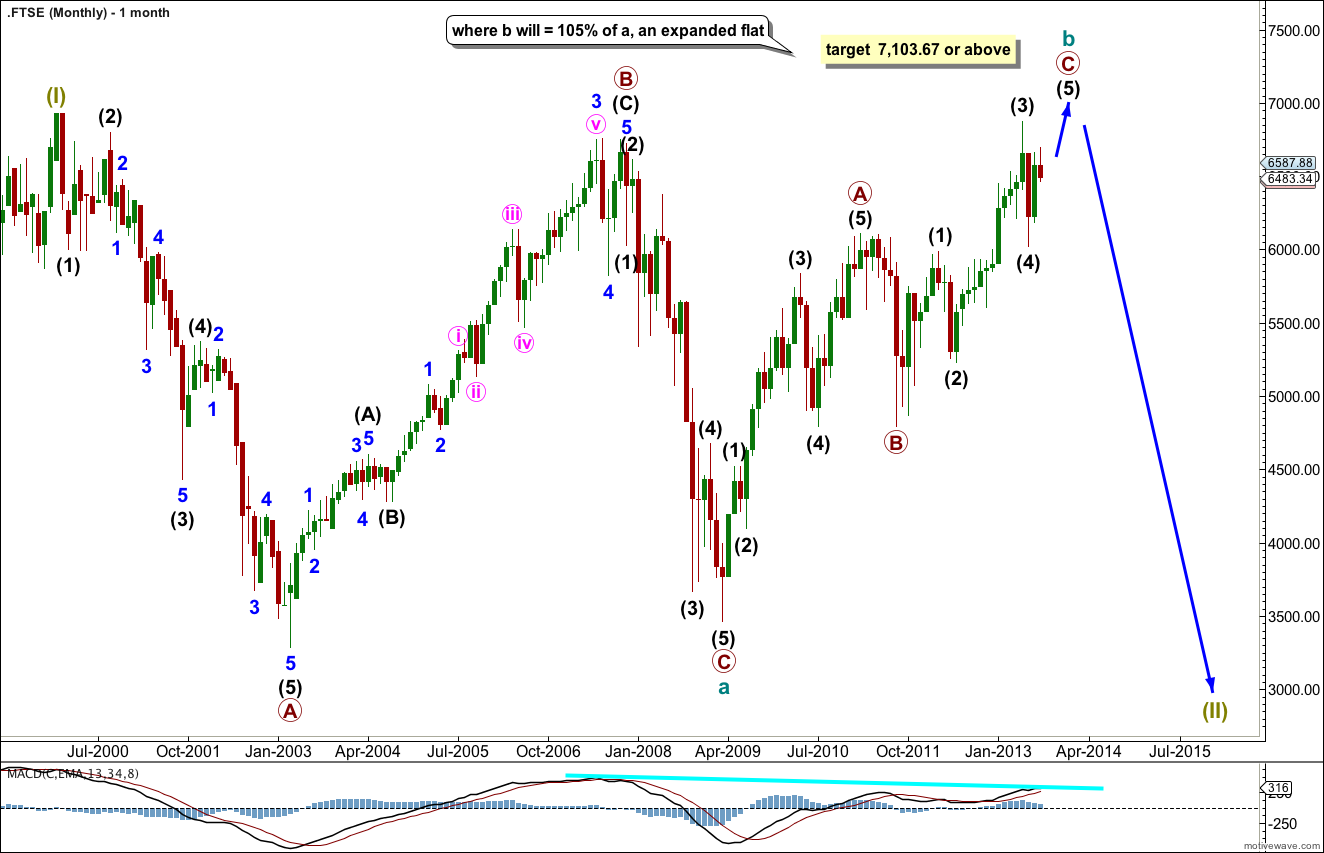This is my first attempt of analysis of FTSE. I have two monthly wave counts for you. They do not differ in expectations in the short to mid term.
Click on the charts below to enlarge.
Main Wave Count.
Within each large movement I have checked subdivisions on the daily chart to see if they fit. This is the best fit that I can see.
Data for FTSE begins in January, 1984. From the initaial low to the all time high labeled super cycle (I) the movement subdivides into an impulse and the movement following it looks typically corrective.
The downwards wave labeled primary wave A subdivides best as a five wave impulse.
Ratios within primary wave A are: intermediate wave (3) is 64.35 points short of 2.618 the length of intermediate wave (1), and intermediate wave (5) has no Fibonacci ratio to intermediate wave (1).
Ratios within intermediate wave (3) of primary wave A are: minor wave 4 is 61.68 points longer than 1.618 the length of minor wave 1, and minor wave 5 has no Fibonacci ratio to either of minor waves 3 or 1.
Ratios within intermediate wave (5) of primary wave A are: minor wave 3 has no Fibonacci ratio to minor wave 1, and minor wave 5 is just 1.9 points short of 2.618 the length of minor wave 1.
Within primary wave B there is no Fibonacci ratio between intermediate waves (A) and (C).
Ratios within intermediate wave (A) are: minor wave 3 is 29.57 points longer than 0.618 the length of minor wave 1, and minor wave 5 is 24.83 points short of 0.382 the length of minor wave 1.
Ratios within intermediate wave (C) are: minor wave 3 is 103.19 points longer than 2.618 the length of minor wave 1 (this is a 5.2% variation so I consider as it is less than 10% it is acceptable), and minor wave 5 has no Fibonacci ratio to minor waves 3 or 1.
Ratios within minor wave 3 of intermediate wave (C) are: minute wave iii has no Fibonacci ratio to minute wave i, and minute wave v is 116.47 points short of 2.618 the length of minute wave i (a 9% variation).
The downwards wave labeled primary wave C of cycle wave a I have checked carefully on the daily chart. It subdivides nicely as a five wave impulse but does not subdivide well as a three wave zigzag. I have placed the intermediate degree labels here after analysis of the daily chart.
Ratios within primary wave (C) are: intermediate wave (3) has no Fibonacci ratio to intermediate wave (1), and intermediate wave (5) is 87.55 points longer than 1.618 the length of intermediate wave (1).
Upwards movement from 3,460.71 looks (so far) corrective and does not subdivide into a five wave structure. This looks so far like a typical B wave.
Within cycle wave b ratios within primary wave A are: intermediate wave (3) is 22.39 points longer than 1.618 the length of intermediate wave (A), and intermediate wave (5) has no Fibonacci ratio to either of intermediate waves (1) or (3).
Within primary wave C there is no Fibonacci ratio between intermediate waves (1) and (3). This makes it more likely that we shall see a Fibonacci ratio between intermediate wave (5) and either of (3) or (1).
At super cycle degree this structure may be an expanded flat: cycle wave a subdivides into a three wave zigzag (with a truncated C wave), and cycle wave b subdivides into a corrective structure and has passed the minimum of 90% the length of wave a.
The most common type of flat is an expanded flat. This requires cycle wave b to reach up to 105% the length of cycle wave a at 7,103.67 or above. The last upwards wave is likely to reach this point.
When primary wave C is a completed five wave structure we may expect a trend change at cycle wave degree.
If cycle wave b reaches 105% the length of cycle wave a at 7,103.67 or above then we may expect cycle wave c to move substantially below cycle wave a at 3,460.71.
If cycle wave b ends before 7,103.67 then we may expect cycle wave c to end just slightly below 3,460.71 as the structure at super cycle wave degree would then be a regular flat correction.
This daily chart focusses on the structure of intermediate wave (4) within primary wave C of cycle wave b.
The correction for intermediate wave (4) is very unlikely to be over. I have tried to see if the downwards movement labeled minor wave A can subdivide as a three or a double three. It fits as neither. It does fit nicely as a five wave impulse, and this is likely only minor wave A of intermediate wave (4).
I would expect minor wave C to end just a little below 6,023 to avoid a truncation.
Intermediate wave (4) may not move into intermediate wave (1) price territory. This wave count is invalidated with movement below 5,989.07.
Alternate Monthly Wave Count.
The subdivisions on this alternate are the same as for the main monthly wave count. Instead of a 5-3-5 zigzag for a cycle wave a this may have been the first structure in a double combination.
The double may be joined by a three, a zigzag, in the opposite direction labeled cycle wave x.
When the upwards zigzag labeled cycle wave x is complete this alternate wave count expects a second corrective structure to unfold which may be either a flat or a triangle and would be labeled cycle wave y. Cycle wave y should end about or just a little below the end of cycle wave a (main count).



